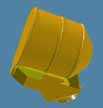(CDA Links)
The dust analyzer (DA) consists of
the following components: four charge pick-up
grids; a hemispherical target, an ion collector, an electron
multiplier, and the sensor electronics.
For information on these components, click on their names.
(DA Links)
The charge pick-up grids collect
the initial  impact particles.
They are mounted at the entrance of the sensor.
impact particles.
They are mounted at the entrance of the sensor.
The hemispherical target is divided
into two parts -- a ring-shaped impact ionization target and
a chemical analyzer target in the middle of the ionization target.
The chemical analyzer target has an acceleration grid mounted
3 mm in front of it.
The ion collector has a grid
that is negatively biased in order to collect the positively
charged plasma ions produced at the impact ionization target.
The electron multiplier is
located in the center of the hemispherical ion collector target.
It amplifies the signal produced by ions capable of penetrating
the ion collector grid. These ions originate from plasma produced
by particle impact either on the impact ionization target or
the chemical analyzer target. The output signal from the multiplier
differs depending upon the target from which impacts are being
measured.
The sensor electronics are contained
in an electronics box attached to the DA sensor chassis. Among
other components, this box contains charge-sensitive amplifiers
(CSAs) that measure the signals from all of the grids in the
DA.
The CDA main electronics includes
amplifiers and transient recorders, a control and timing unit,
a microprocessor unit, a bus interface unit, a power input circuit,
a low-voltage converter, and a housekeeping system.
All CSA and electron multiplier signals are separately amplified
by logarithmic amplifiers and then digitized by an analog-to-digital
converter. The data are stored on transient recorders. Only the
recorder connected to the pick-up grids is operated continuously.
All others are activated only by a signal detected at a target
or the acceleration grid. The control and timing unit stores
and decodes information received from the microprocessor and
produces all timing and synchronization signals required for
instrument operation.
The microprocessor samples and collects the buffered measurement
data, coordinates the subsystem measurement cycle, controls the
instrument operating modes, processes the data according to a
program loaded in its memory, and outputs data to the spacecraft
upon request through the bus interface unit (BIU). The BIU is
the interface circuit between the spacecraft and the microprocessor
and is powered by the CDA instrument. The power input circuit
is the interface with the spacecraft Power and Pyrotechnics Subsystem
(PPS) and contains a filter circuit and a regulator to produce
a d.c. voltage to feed the low-voltage converter.
The low-voltage converter is a d.c./d.c. converter that provides
different regulated low voltages for the electronics circuits
and the supply voltage for the high-voltage converters. The converters
are synchronized to the 100-kHz clock provided through the BIU
from the Command and Data Subsystem (CDS).
The CDA housekeeping system is a data system that multiplexes,
digitizes, and stores information on the instrument current,
the low voltages, the high voltages, and temperature measurements.
The articulation mechanism (AM) allows
the entire CDA instrument, including the high-rate detectors,
the dust analyzer, the main electronics, and the articulation
mechanism electronics, to be rotated or repositioned with respect
to the spacecraft coordinate system.
The high-rate detectors (HRDs) are
two redundant independent sensors. The electronics for the sensors
are contained in the HRD electronics box, and each sensor has
its own electronics, independent of the other sensor. The HRD
will be operated in two modes: "normal" mode and "calibrate."
In the normal mode, the operational HRD continuously collects
dust particle data. In the calibrate mode, a calibration cycle
is initiated, which consists of a sequence of pulses sent to
the HRD by the in-flight calibrator (IFC) to verify the stability
of the electronics.
 observations
of dust and ice particles in interplanetary space and in the Jupiter
and Saturn systems. It will investigate the physical, chemical,
and dynamical properties of these particles matter as functions
of the distances to the Sun, to Jupiter, to Saturn, and to Saturn's
satellites and rings. Finally, it will study the interaction of
the particles with the Saturnian rings, satellites, and magnetosphere.
observations
of dust and ice particles in interplanetary space and in the Jupiter
and Saturn systems. It will investigate the physical, chemical,
and dynamical properties of these particles matter as functions
of the distances to the Sun, to Jupiter, to Saturn, and to Saturn's
satellites and rings. Finally, it will study the interaction of
the particles with the Saturnian rings, satellites, and magnetosphere.